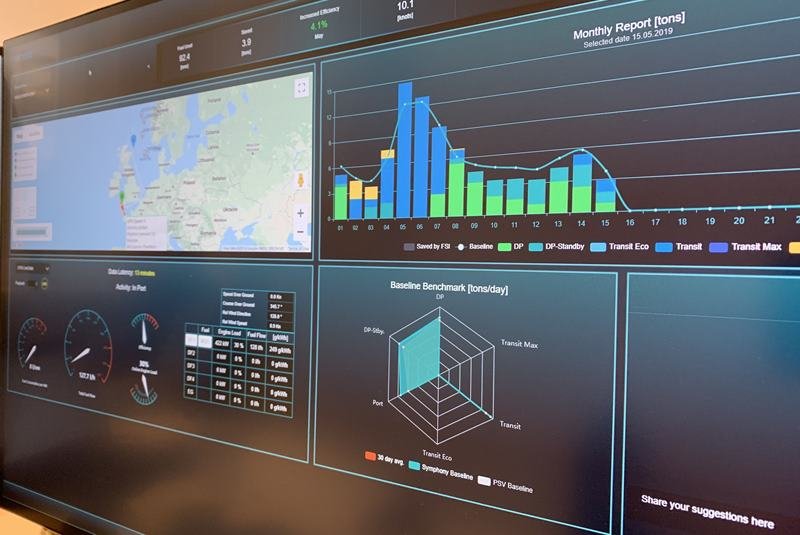In their insightful article, John Oosthoek, VP Digital at VPS and Ruben Hofsli, Maritime Decarbonisation Manager at VPS, explore the evolving landscape of the maritime shipping industry. As experts in digital solutions and sustainable practices, Authors sheds light on the critical challenges faced by the industry, emphasizing the role of data-driven decision-making in enhancing fuel procurement processes and optimizing overall fuel efficiency. With a focus on real-world cases and the impactful contributions of VPS solutions like PortStats and Maress, Oosthoek and Hofsli provide valuable insights into how data analytics can play a pivotal role in steering the shipping sector toward a more environmentally conscious and operationally efficient future.
Maritime shipping, which already is the most carbon efficient way of transporting goods, accounts for over 80% of world trade transports and for only 2.1% of the world’s carbon dioxide emissions (World Shipping Council, 2023). In this global industry, where ships navigate a myriad of issues in a ceaseless dance of commerce and transport, our customers are facing a critical challenge – decarbonising their fleet operations.
Illustrated by initiatives such as the carbon intensity indicator (CII), a regulation introduced by the IMO in 2022, as well as the European Union’s FuelEU maritime initiative entering into force in 2025, there are growing societal and regulatory pressures on the shipping sector to reduce their environmental footprint. Clear targets have been recently revised by the IMO: 20% emissions reduction by 2030 and 70% by 2040 to reach net zero by 2050.
A key aspect in the pathway towards decarbonisation of the shipping sector is the efficient use of marine fuels. The quality and composition of marine fuels directly impact vessel performance, environmental sustainability, and operational costs. As the global leader in testing the quality of marine fuels, VPS assists its customers to navigate the complexities of marine fuel procurement, -treatment and -management. In this article, we delve into the growing role of data-driven decision-making in the shipping industry, with a specific focus on how our customers are harnessing our data analytics solutions such as PortStats and Maress to optimise fuel procurement decision-making, prevent off-spec fuels from causing vessel downtime and reduce the environmental footprint of their fleet.
Using PortStats to anticipate fuel off-specs and optimise calorific value
Let us consider the case of a fuel procurement Director at a large ship owner-operator. As this company both owns the vessels and operates them, any fuel costs, as well as costs due to unplanned maintenance events directly impact the companies bottom-line. The fleet typically bunkers in hubs such as Singapore, Rotterdam and Houston, but also has some fuel deliveries planned in other ports such as Cartagena, Port Klang and Lome.
This user experienced two clear benefits from using our PortStats solution:
- By using PortStats to benchmark their existing fuel deliveries in Singapore, Rotterdam and Houston, the company was able to cherry-pick the most reliable suppliers in these ports, whilst also getting higher calorific value fuels in the process. This saved the company ca. 80,000 MT of marine fuel per year purely on energy.
- The company was also able to prevent off-specs from negativel affecting their vessels. The user noticed a relatively high number of cat fines and TSP off-specs with one of their short-listed suppliers.
Whilst this may have been the top choice based on price, the company used the quality scorecards feature in PortStats to evaluate the market situation and ended up going with the slightly more expensive alternative, which had much lower AlSi and no TSP off-specs, thus mitigating any consequent risks for engine damage.
“I would just like to say that this tool is truly amazing. With the new advanced supplier benchmarking feature in PortStats, you have gold in your hands for the bunker buyers and traders.” – Director Fuel Procurement
Poor fuel management is one of the top three immediate causes for main engine damage, with an average cost of ca. $344,000 per incident (The Swedish Club, 2018). PortStats helps users to prevent off-specs and to be aware of potential operational considerations based on the quality of the fuels before bunkering. Furthermore, as the calorific value of marine fuels is an important decision-making factor, PortStats makes this variable transparent, giving bunker traders and bunker buyers and important lever in determining the true value of a bunker stem.
Using Maress to optimise fuel efficiency and reduce CO2 emissions
Now let us consider the case of connecting data from ship-to-shore. Nowadays, the majority of shipowners have operational data flowing from their vessels to their shore facilities in one way or another. Some of them have advanced systems in place, with high frequency data being available, whilst others rely on noon-reports. Typically, the equipment and technology that is available differs from vessel to vessel. The challenge then becomes to assess whether the available data is good enough and how to utilise this data to gain valuable insights.
Maress is the VPS solution focused on helping shipowners to systemise the data they already have at their disposal. Through visualising and reporting this data, Maress creates data transparency for our customers.
when it comes to fuel consumption. As a result, these companies are able to increase their focus on fuel efficiency across the board – from the crew onboard of the vessels to the onshore operational staff supporting them.
The Tidewater Case
One of these shipowners with a large and diverse fleet is Tidewater. For years, they have reported fuel consumption in a system where consumption and activity are mapped, but it was hard to measure any changes other than on a monthly or yearly basis. It was even harder to see if there was anything wrong with the reported numbers. As a result, fuel consumption data was not actively used to improve the fuel efficiency for the Tidewater fleet.
Maress was introduced in late 2020 for the Norwegian Tidewater fleet, using historical data that Tidewater had from the beginning of 2018. We started by simply uploading the history data in Maress. Now that the data was visual for all crew and onshore staff, it became much clearer for them to see what they should focus on. One important aspect of the success story of Tidewater was that they got the vessels’ crews involved with Maress early on in the process, for example by writing comments in Maress on what they have done to improve fuel efficiency and to discuss the challenges they meet during offshore operations that have an impact on the fuel consumption.
Some of these challenges included: technical problems on board of the vessels, at installation or at the onshore base, orders from the charterer to increase the speed during transits or severe weather conditions. The crews were also sharing what they did to improve fuel efficiency, such as reducing speed to transit on one engine, active communication with the charterer on when they needed to be at the location to help optimise the transit and stopping of unnecessary fuel consumption in port. From the onshore staff’s side, the customer now had a tool to use when communicating internally, as well as with clients. They also now have the possibility to discuss how the vessel’s operations can affect its fuel consumption.
One concrete example of this was when their shore staff was analysing the data, and they noticed that one vessel was using the same amount of fuel per hour in Standby (waiting on the offshore field), as they did when they were in Full DP mode, working close to the installation. The data was clear, and the onshore operational team then asked the captains about this. The reply was short: “In standby, we put the vessel in full DP so we are ready if the installation needs us, and we have done it like this for six years.” After some internal discussions, they agreed on a new approach. In cooperation with the installation, they agreed on a response time for work. This allowed the vessel to drift more while waiting, which reduced the required engine power substantially. As a result, they decreased fuel consumption while in standby by ca. 30%. Without Maress to visualise the data and to provide the actionable insights to both the shore
staff as well as the vessel’s crew, it would have been difficult to catch this.
In the period from 2020 through 2022, the Norwegian Tidewater fleet reduced fuel consumption with an incredible 20% (ca.), simply by increasing their data awareness and focus on fuel efficiency by using Maress as their data-driven decision-making tool.
Over time and without any high-cost CAPEX, the quality of the fuel consumption reports improved rapidly. Their fleet’s fuel efficiency was improving simply because the data was visualised in a user-friendly and understandable way. Tidewater then adopted the reporting scheme globally and then expanded their subscription to Maress to the global fleet. Cooperation, communication, and crew involvement were the key success factors that made the Tidewater case a success story in the path to more fuel-efficient operations.
Source VPS

